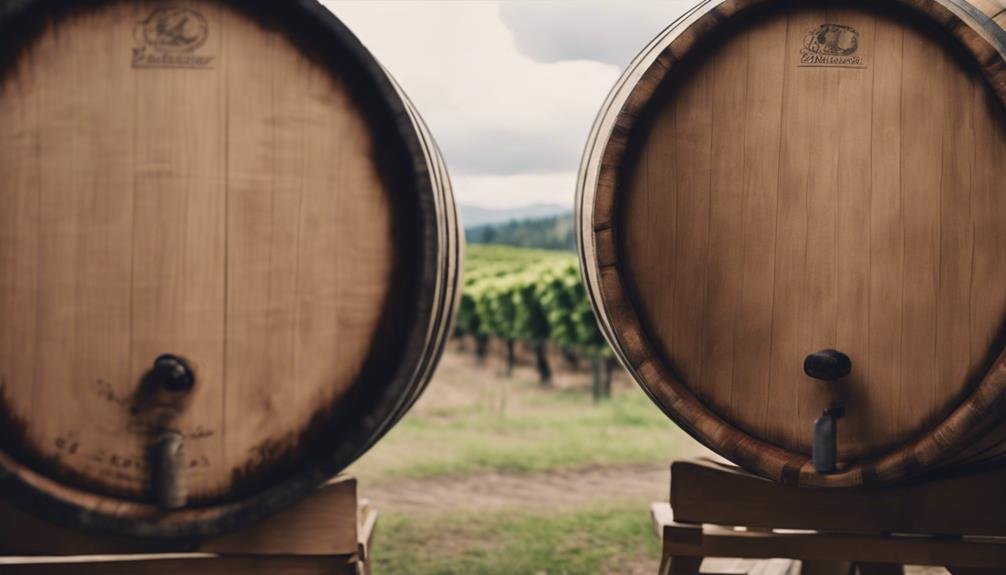Malolactic fermentation is vital in winemaking, shaping texture, flavor, and creating buttery aromas. Bacteria like Oenococcus oeni convert malic to lactic acid, enhancing aroma development. The process softens acidity, smoothens texture, and adds complexity with CO2 release. It influences wine characteristics, playing a key role in balancing acidity and enhancing sensory properties. Butter and cream aromas come from diacetyl release, contributing to a velvety mouthfeel. Understanding its impact is essential for wine enthusiasts seeking richness and depth in their wines.
Importance of Malolactic Fermentation
Malolactic fermentation plays a significant role in shaping the texture and flavor profile of wines by converting sharp malic acid into smoother lactic acid through the action of specific bacteria. This process, integral to winemaking techniques, not only reduces acidity but also enhances aroma development through microbial activity.
The conversion of malic acid by bacteria like Oenococcus oeni results in wines with a velvety texture and a more complex flavor profile. Aroma enhancement is a key outcome of this fermentation process, with the release of compounds like diacetyl contributing to buttery and creamy aromas in the wine.
Understanding the impact of malolactic fermentation on wine's sensory characteristics is essential for winemakers seeking to create wines with distinct textures and flavors.
Malolactic Fermentation Process
During the transformation of wine acidity, a microbial conversion process occurs that alters the sensory properties and mouthfeel of the final product. This process, known as malolactic fermentation, involves bacterial conversion where lactic acid is produced from tartaric acid, resulting in a smoother taste and texture in the wine. The reduction of tartness and the release of carbon dioxide are key outcomes of this conversion. Below is a table illustrating the key points of the malolactic fermentation process:
| Process Step | Description | Outcome |
|---|---|---|
| Bacterial Conversion | Bacteria convert malic to lactic acid | Softens wine acidity |
| Acid Transformation | Tartaric acid transformed to lactic acid | Smoothens wine texture |
| Release of CO2 | Carbon dioxide is released during process | Adds complexity to wine |
This transformation plays an important role in shaping the final characteristics of the wine, particularly regarding texture and acidity balance.
Impact on Wine Aromas

The transformation brought about by malolactic fermentation profoundly influences the aromatic profile of wines. Through this process, aroma development is key in creating wine's complex bouquet. Malolactic fermentation can lead to the enhancement of flavors, contributing to the richness and depth of the wine.
One significant impact is the development of buttery and creamy aromas, attributed to the release of diacetyl during fermentation. This flavor enhancement can provide a velvety texture to the wine, creating a more rounded mouthfeel.
Additionally, the conversion of malic acid to lactic acid during malolactic fermentation helps to reduce the wine's acidity, resulting in a smoother taste. Overall, the influence of malolactic fermentation on wine aromas is essential in shaping the overall sensory experience for wine enthusiasts.
Malolactic Fermentation in Winemaking
In the intricate process of winemaking, the transformation brought about by malolactic fermentation plays a pivotal role in shaping the final sensory characteristics of the wine. This bacterial conversion is essential for flavor development, as it converts tart malic acid into softer lactic acid, reducing acidity and enhancing texture.
Through the action of bacteria like Oenococcus oeni, this process not only contributes to the reduction of acids but also releases carbon dioxide, resulting in a wine with a creamy, velvety texture. The acid reduction and texture enhancement achieved through malolactic fermentation are fundamental in creating wines with a smoother mouthfeel and a more rounded flavor profile, making it an indispensable step in the winemaking process.
Considerations for Malolactic Fermentation

Considering the impact of malolactic fermentation on flavor development and texture enhancement in winemaking, various factors need careful consideration to guarantee the best outcomes.
- MLF benefits, challenges:
- Benefits include enhanced complexity and mouthfeel.
- Challenges involve the risk of spoilage if not monitored closely.
- MLF microbial interactions:
- Oenococcus oeni is the primary bacteria used.
- Interactions with other microbial species can affect the process.
- Temperature control:
- Maintaining ideal temperatures is essential for successful MLF.
- Extreme temperatures can stall or kill the bacteria.
- Chemical analysis:
- Regular testing for malic acid levels helps track the progress.
- Monitoring pH levels ensures a suitable environment for MLF.
Frequently Asked Questions
Are All Wines Affected by Malolactic Fermentation?
Not all wines undergo malolactic fermentation. While common in red wines for added complexity and texture, white wines may undergo partial conversion, preserving fruity aromas. This process influences wine complexity and flavor profiles, enhancing richness.
Can Malolactic Fermentation Occur in the Bottle?
In the domain of wine production, it is significant that malolactic fermentation does not typically occur in the bottle. Proper storage conditions, excluding this process, are vital to maintaining wine quality during bottle aging.
Does Malolactic Fermentation Affect Wine Color?
Malolactic fermentation does not directly impact wine color stability. However, it plays an essential role in flavor development by converting harsh malic acid into softer lactic acid. This process can enhance the overall complexity and mouthfeel of the wine.
Can Malolactic Fermentation Be Stopped or Reversed?
Stopping malolactic fermentation can be achieved by controlling bacteria activity through sulfites or cold stabilization. Reversing the process is challenging but possible with sterile filtration. Acidic wines benefit from halting MLF to maintain freshness and fruitiness.
Are There Health Concerns Related to Malolactic Fermentation?
Potential health risks associated with malolactic fermentation stem from the production of biogenic amines, like histamine, which can trigger adverse reactions in sensitive individuals. Understanding this aspect of the fermentation process is essential for consumer health.
Conclusion
In the world of winemaking, malolactic fermentation plays a vital role in creating the buttery aromas that enhance the sensory experience of wines. This transformative process not only softens acidity but also adds richness and complexity to the final product.
With its ability to shape the character of wines, malolactic fermentation stands as a key player in the intricate dance of science, tradition, and innovation in the domain of viniculture.
